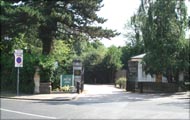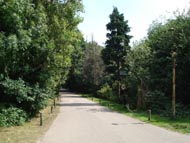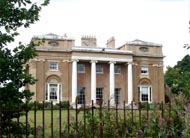Convalescent
During WW1, in 1916, Grovelands House, which had stood empty for 11 years, became the Southgate Auxiliary Military Hospital, run by members of Southgate Branch Voluntary Aid Detachment (V.A.D.) of the Middlesex Voluntary Aid Organisation.
At first the Hospital, which was affiliated to the Edmonton Military Hospital, had 60 beds. The number was later increased to 78 and, by 1917, there were 160 beds. By the end of the war in 1918, the Hospital had 134 beds.
In 1921, the Great Northern Central Hospital acquired the site when the loan of its convalescent home at Summerlee expired.
The house was surrounded by a moat which had originally been installed to prevent deer from the park from straying too near. It stood in extensive and beautifully wooded grounds and enjoyed an uninterrupted view as far away as High Beech in Epping Forest. Within the grounds was a pleasure lake, some 7 acres in extent, which would be seen from most windows of the house. Other windows overlooked the walled garden.
Grovelands was officially opened as the Great Northern Home of Recovery by the Princess Royal, Duchess of Fife, on 9th July 1921. The convalescent home had 60 beds, although initially only 40 patients were admitted. Female patients were accommodated in the drawing rooms and male patients in a newly built annexe. A small children's ward was on the floor above; it was painted white and decorated with a frieze depicting the seaside.
Many of the rooms retained their original decoration from the late 18th century, which had been executed by Italian artists specifically brought over for the purpose. One particular example was the octagonal Birdcage Room, so-called because its structure resembled a birdcage.
The Home had no Resident Medical Officer, but its patients were directly under the supervision of the medical staff of the Great Northern Central Hospital (later renamed the Royal Northern Hospital). The nursing staff consisted of a Matron, a Sister, a Staff Nurse and some junior nurses. They were accommodated on the top floor of the house (one bedroom opened out onto the roof, where the nurses could sleep on warm nights). The domestic staff were housed in the stables, which had been converted into cubicles for the purpose. The vinery - a spacious room - was used to supplement the kitchen accommodation.
In 1926 an additional 20 acres of land were purchased.
During WW2 the building was damaged by a bomb in 1941.
The Home joined the NHS in 1948, along with its parent Hospital, under the control of the Northern Group Hospital Management Committee, part of the North West Metropolitan Regional Hospital Board.
In 1973 it became a pre-convalescent unit containing 56 beds, providing nursing care for patients following surgery, thus freeing up acute beds at the main hospital.
In
1974, following a major reorganisation of the NHS, the Northern Group
of hospitals came under the control of the North East Thames Regional
Health Authority. The Royal Northern Hospital then was
administered by the Islington District Health Authority, while
Grovelands came under the auspices of Enfield District Health Authority.
Grovelands closed in 1977.
Present status (July 2008)
The house remained unoccupied until it was sold in 1985.
After extensive renovation the Grade I listed neo-classical villa reopened in 1986 as the Grovelands Priory, a private psychiatric hospital.
General Augusto Pinochet, the former dictator of Chile, was admitted here in 1998 for several weeks from the London Clinic in central London, as the security arrangements were more manageable. He had been arrested and bailed, and was awaiting a House of Lords decision as to whether he could be extradited to Spain to face charges of murder. In the event, he was not, and returned to Chile.


The entrance and the driveway to the house

Grovelands Priory
Grovelands, originally named Southgate Grove, had been built in 1797 by John Nash for the Quaker brandy merchant, Walker Gray. The landscape designer Humphry Repton designed the gardens and created the artificial lake with its islands by damming the Bourne stream.
Walker Gray died in 1834 and the estate was inherited by John Donnithorne Taylor, who renamed it Woodlands, then Grovelands. Taylor purchased neighbouring land as it became available so that the area would remain rural. By his death in 1885 he had accumulated over 600 acres.
The estate passed to his son and grandson, who sold the southern extension in 1902 for development as housing.
The family remained at Grovelands until 1907, when the house became unoccupied. In 1911 Southgate Urban District Council purchased 64 acres of the grounds for use as a public park, which opened in 1913.
(Author unstated) 1917 List of the various hospitals treating military cases in the United Kingdom. London, H.M.S.O.
(Author unstated) 1921 The hospital world. British Journal of Nursing, 9th July, 27.
(Author unstated) 1921 A Home of Recovery. British Journal of Nursing 20th August, 119.
Fenn CR 1919 Middlesex to Wit. London, St Catherine Press.
www.aim25.ac.uk
www.british-history.ac.uk
www.britishlistedbuildings.co.uk
www.enfield.gov.uk
www.geograph.org.uk
www.geolocation.ws
www.kentvad.org
www.nationalarchives.gov.uk
www.n21.net
www.parkexplorer.org.uk
www.the-archer.co.uk
www.tlemea.com (1)
www.tlemea.com (2)
Return to home page